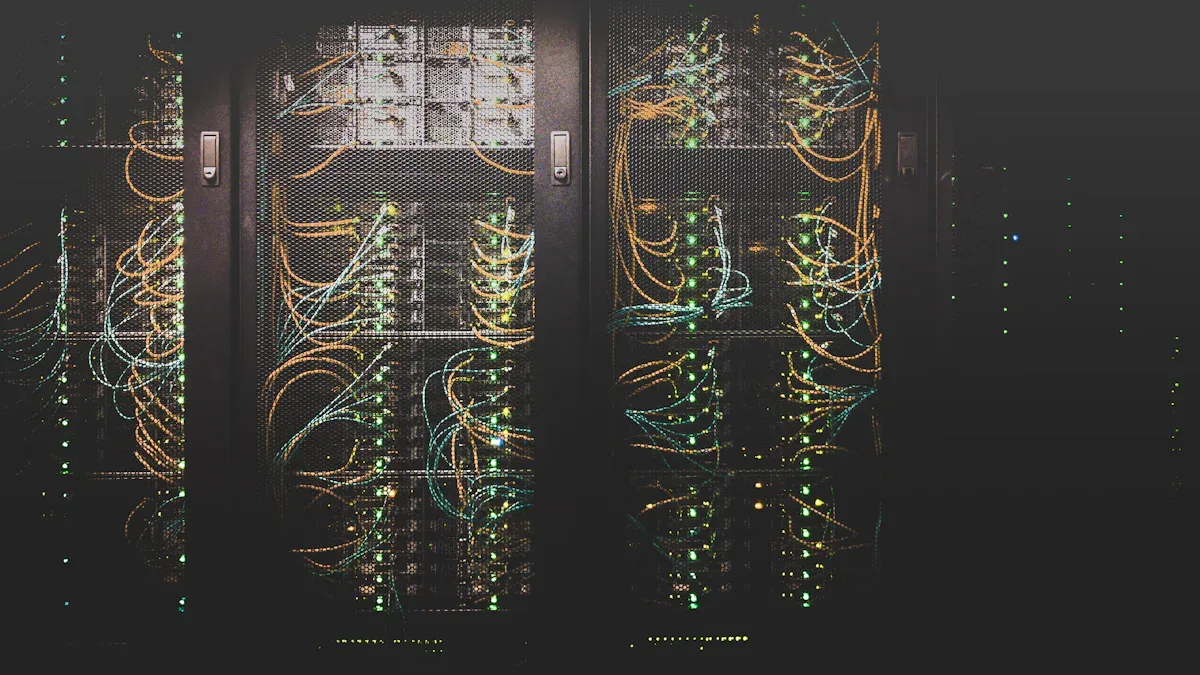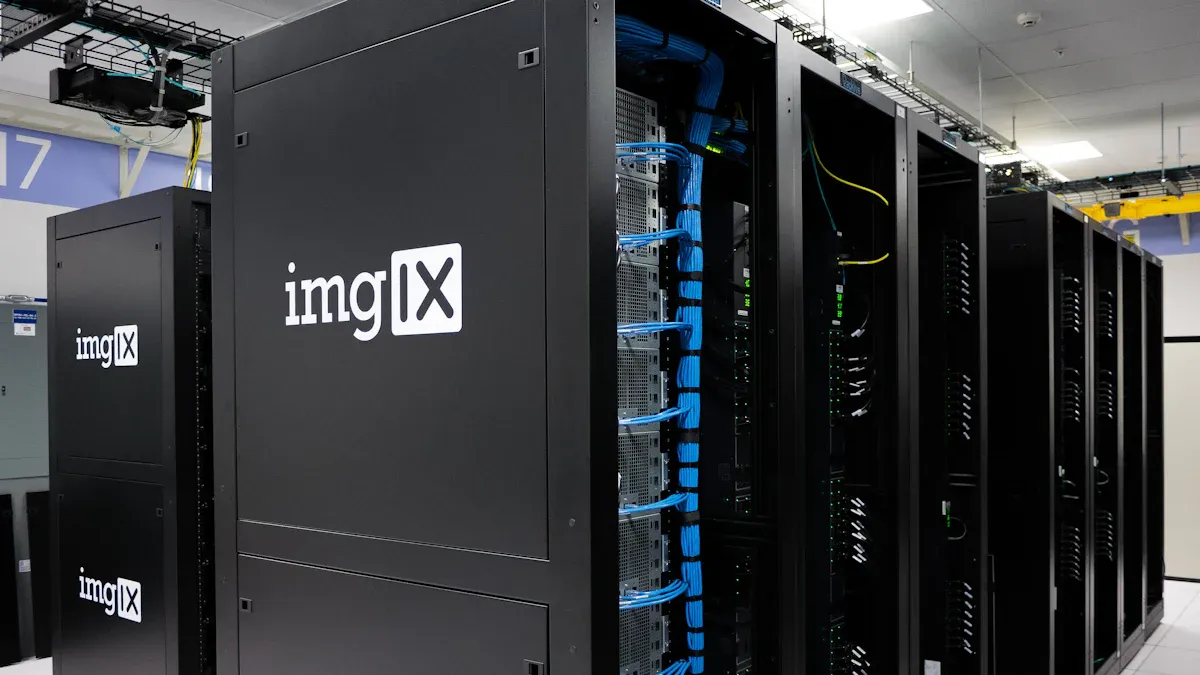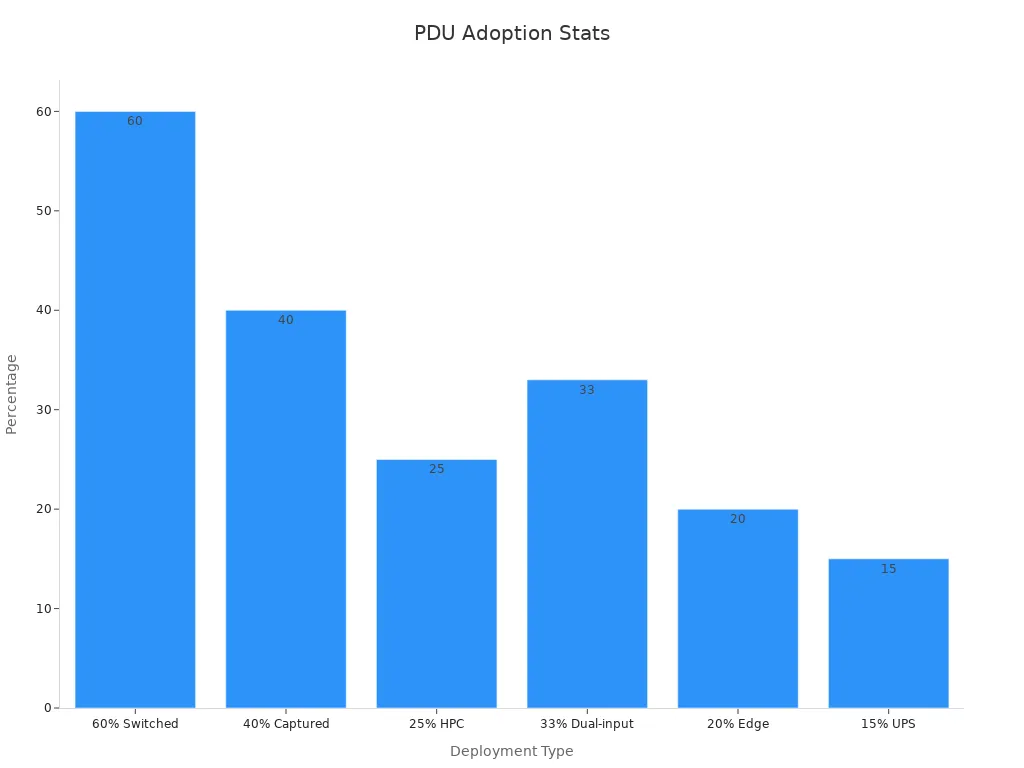
APC by Schneider Electric sets the standard for intelligent PDU solutions, offering unmatched reliability, advanced features, and robust support. Enterprises see up to 30% operational cost savings and a 15% reduction in unintentional outages with these systems. Selecting the right PDU, whether intelligent or basic PDU, ensures optimal performance and maximum return on investment.
Key Takeaways
- Intelligent PDUs offer real-time power monitoring, remote control, and environmental sensing, helping enterprises reduce downtime and save energy costs.
- Choosing the right PDU involves considering remote management, scalability, security, and integration with existing systems to support future growth and operational efficiency.
- Leading brands like APC by Schneider Electric provide advanced features, modular designs, and energy efficiency that help enterprises meet sustainability goals and improve reliability.
What Is an Intelligent PDU?
Key Features Explained
Intelligent PDUs represent a significant advancement in power distribution technology. These devices offer real-time monitoring, remote management, and environmental sensing at the rack level. Key features include metering at the unit, inlet, and outlet levels, which allows precise tracking of power usage and capacity. Advanced models provide network interface cards for remote access, enabling administrators to control power cycling and switch devices on or off from anywhere. Environmental sensors monitor temperature, humidity, and airflow, helping prevent overheating and equipment failure.
Security remains a priority. Intelligent PDUs include secure access, encryption, and contact closure for cabinet door locks. Firmware updates and SNMP trap notifications ensure operational enhancements and timely alerts. Modular designs allow enterprises to expand their infrastructure by adding up to ten PDUs without disruption. The following table highlights performance benchmarks for intelligent PDUs:
| Metric/Feature | Benchmark/Improvement |
|---|---|
| Coefficient of Performance (COP) | Improved to 1.96 |
| Cooling System Energy Consumption | Reduced by 5.8% |
| Power Usage Effectiveness (PUE) | Reduced by 0.013 |
| Annual Electricity Cost Savings | Decreased by 21% |
| Scalability | Supports growth without disruption |
Why Enterprises Need Intelligent PDUs
Enterprises rely on intelligent PDUs to maintain high power quality, ensure uptime, and optimize energy efficiency. These devices provide real-time monitoring at the outlet level, enabling precise power consumption tracking and early detection of potential issues. Integration with data center infrastructure management systems allows automated power management and improved capacity planning. Intelligent PDUs help identify underutilized servers, optimize load balancing, and reduce operational costs by powering down unused equipment remotely.
They also support sustainability goals by lowering energy consumption and reducing carbon footprint. Enhanced safety features minimize risks such as overheating and fires. As data centers grow in complexity, intelligent PDUs enable scalability and compliance with service level agreements, building customer trust and supporting future expansion.
Top Intelligent PDUs Compared

APC by Schneider Electric PDU
APC by Schneider Electric stands out as a leader in the intelligent PDU market. Enterprises trust this brand for its robust design, advanced features, and consistent performance. Independent testing rates the APC Rack PDU highly in several categories, including design (9.5), performance (9.0), and feature set (9.2). The product holds certifications such as ISO9001, UL, RoHS, CE, and VDE, confirming its compliance with global standards.
APC’s modular design supports scalability, making it suitable for large-scale data centers. Advanced features like remote monitoring, outlet-level control, and seamless integration with DCIM systems provide detailed power usage insights. The energy-efficient design helps organizations meet sustainability goals while reducing operational costs. Enterprises with high-density power needs benefit from three-phase options, ensuring reliable power distribution.
- Key Strengths:
- High reliability and quality
- Comprehensive certifications
- Advanced monitoring and control
- Scalable and modular design
- Energy efficiency for sustainability
Vertiv Geist PDU
Vertiv Geist delivers flexible and reliable power distribution for diverse enterprise environments. The Geist UPDU supports universal input and high power capacity up to 22kW, making it ideal for global deployments. Switched models offer outlet-level remote monitoring and control, which enhances management of critical IT equipment.
- Universal input and high power capacity
- Outlet-level control for remote power management
- Bi-stable latching relays reduce idle power consumption
- Accurate local and remote power monitoring (+/- 1%)
- Environmental monitoring with optional sensors
- High temperature tolerance up to 60°C
- Flexible mounting and configuration options
- Power sequencing to prevent overloads
- U-Lock receptacles for secure connections
- Every unit undergoes 100% reliability testing
- Standard 3-year warranty, extendable to 5 years
Vertiv Geist PDUs fit a wide range of industries, including education, government, telecom, and retail, offering reliability and intelligent power distribution.
Eaton ePDU
Eaton ePDU products focus on efficiency and precise power management. These units deliver billing-grade accuracy and advanced monitoring capabilities. The following table highlights key performance benchmarks:
| Benchmark Description | Value / Feature | Efficiency Highlighted |
|---|---|---|
| Billing Grade Accuracy | 1% accuracy | Precise power monitoring for accurate billing |
| Daisy Chain Capability | Up to 8 ePDUs on one IP address | 87.5% reduction in network infrastructure costs |
| Level 3 PUE Measurement | 15-minute intervals or less | Highly accurate power usage effectiveness measurement |
Eaton ePDU supports daisy chaining, which reduces network infrastructure costs and simplifies management. Continuous PUE measurement helps organizations optimize energy usage and improve operational efficiency.
Raritan PX Series PDU
Raritan PX Series offers intelligent power distribution with a focus on high-density and mission-critical environments. These PDUs provide real-time power monitoring at the outlet, inlet, and branch circuit levels. The PX Series supports remote outlet switching, environmental monitoring, and integration with leading DCIM platforms.
Raritan’s modular approach allows for easy expansion as data center needs grow. The PX Series also features secure access, advanced alerting, and a wide range of form factors to fit different rack configurations. Enterprises seeking granular control and detailed analytics often choose Raritan for its reliability and flexibility.
Server Technology PDU
Server Technology PDUs deliver operational reliability and advanced management features for data centers. Smart PDUs enable real-time monitoring and early detection of power issues, which improves uptime and reduces energy costs. Case studies show a 15% reduction in energy costs and 99.99% uptime for cloud service providers using these units.
Managed PDUs from Server Technology include over-temperature and over-current protection, remote management, and integration with cluster management software. These features support proactive fault isolation and automated control, maintaining high availability. Secure protocols and support for power fencing further enhance reliability in demanding environments.
CyberPower PDU
CyberPower offers a range of intelligent PDUs designed for small to medium-sized enterprises and edge deployments. These units provide real-time monitoring, remote switching, and surge protection.
CyberPower PDUs feature user-friendly interfaces and support integration with network management systems. The brand emphasizes value and ease of use, making it a popular choice for organizations seeking reliable power distribution without complex setup. Environmental monitoring and customizable alerts help maintain uptime and protect sensitive equipment.
Ubiquiti PDU Pro
Ubiquiti PDU Pro combines advanced features with cost-effectiveness, making it attractive for enterprises seeking value and functionality. The following table compares key features with traditional power strips:
| Feature | Ubiquiti PDU Pro | Traditional Power Strip |
|---|---|---|
| Remote Power Control | Yes | No |
| Power Scheduling | Yes | No |
| Individual Outlet Control | Yes | No |
| Surge Protection | Yes | Limited |
| Energy Monitoring | Yes | No |
Ubiquiti PDU Pro enables remote management, power scheduling, and energy monitoring, which reduce downtime and operational costs. Administrators can reboot devices remotely, saving time and improving efficiency. The product’s competitive pricing and rich feature set make it a strong choice for managed service providers and data centers looking to optimize power management.
Key Decision Factors for PDU Selection
Remote Management Capabilities
Enterprises prioritize remote management when selecting intelligent PDUs. This feature allows IT teams to control power, monitor usage, and receive alerts from any location.
- Remote power control enables rebooting idle servers and shifting power loads efficiently.
- Integrated environmental sensors provide alerts on temperature and humidity.
- Security features such as firewalls and password protection support safe remote access.
- Switched PDUs allow remote power on/off at the outlet level, preventing overloads and reducing downtime.
- Out-of-band communication ensures redundancy if the main network fails.Remote management proves essential for organizations with distributed or edge sites, offering quick ROI and enhanced uptime.
Integration with Existing Systems
Seamless integration with data center infrastructure management (DCIM) systems streamlines operations. Intelligent PDUs connect with monitoring platforms, enabling centralized control and advanced reporting. This integration optimizes energy use and supports proactive maintenance, reducing manual intervention and preventing equipment failures.
Scalability and Flexibility
Scalability ensures that the power distribution solution grows with the business. Modular PDUs support expansion without major upgrades. Flexible mounting and configuration options allow adaptation to changing rack layouts and high-density deployments.
Security and Compliance
Security remains a top concern. Intelligent PDUs offer encryption, authentication, and secure access controls. These features help enterprises comply with industry regulations and protect critical infrastructure from unauthorized access.
Cost and Total Value
A cost-effective PDU delivers more than just a low purchase price.
| Metric | Before Implementation | After Implementation | Improvement / Benefit |
|---|---|---|---|
| Annual Energy Expenses | N/A | $50,000 reduction | Significant annual cost savings |
| Downtime Incidents | N/A | 30% decrease | Enhanced reliability, reducing operational costs |
| Equipment Longevity | N/A | Extended | Prevention of overloading, reducing replacement and maintenance costs |
| Scalability | Limited | High | Supports future growth, avoiding costly upgrades |
Intelligent PDUs provide ongoing operational savings, improved reliability, and support for future growth, making them a smart investment for enterprises.
Matching PDU Solutions to Enterprise Use Cases

Data Center Environments
Modern data centers demand advanced power management to support AI, cloud, and high-performance computing. Intelligent solutions enable remote outlet control, power cycling, and detailed energy tracking. Over 60% of new AI-optimized rack deployments specify switched units for these capabilities. Nearly one-third of new AI data halls require dual-input intelligent models for redundancy. The following table highlights adoption trends:
| Statistic / Trend | Supporting Detail |
|---|---|
| Over 60% of new AI-optimized rack deployments specify switched PDUs | Enables remote outlet control and power cycling capabilities |
| Intelligent PDUs capture more than 40% of new rack deployments | Driven by power usage effectiveness (PUE) tracking capabilities |
| Rack power demands exceed 25 kW in AI and HPC workloads | Drives demand for intelligent and switched PDUs |

Edge Computing and Remote Sites
Edge and remote locations benefit from compact, modular power solutions. These units offer remote monitoring, surge protection, and temperature sensing. Telecommunications companies have improved network reliability at remote towers by using real-time power monitoring and fault isolation, which reduces downtime and maintenance costs. Redundant systems and modular configurations ensure continuous operation and easy upgrades as needs evolve.
High-Density Power Needs
High-density environments require solutions with high outlet density, robust metering, and secure remote control. Some models support up to 48 outlets per unit and 8.6 kW capacity, with advanced metering for watt-hour, voltage, and current. Daisy-chaining allows up to four units on a single IP address, while vertical and horizontal mounting options provide installation flexibility. The intelligent rack segment is projected to grow at a 10.7% CAGR, reflecting rising demand for these features.
Sustainability-Focused Deployments
Organizations focused on sustainability leverage intelligent power management to reduce operational costs and improve energy efficiency. Real-time monitoring and DCIM integration can lower operational costs by up to 30% and improve PUE from 1.7 to as low as 1.2. These solutions support high-density configurations and enable proactive maintenance, helping enterprises meet environmental goals.
| Energy Efficiency Benefit | Description | Impact |
|---|---|---|
| Operational Cost Reduction | Reduces operational costs by up to 30% | Up to 30% cost savings |
| PUE Improvement | Improves PUE from 1.7 to as low as 1.2 | Significant energy efficiency gain |
| DCIM Integration | Reduces costs by 20%, improves PUE to 1.5 | Enhanced energy management |
High-Security Environments
Enterprises with strict security requirements rely on advanced power management for multilayer redundancy, failover support, and secure network protocols. Industrial-grade controllers allow hot-swappable replacement, while environmental and physical security sensors enhance oversight. Secure authentication and network safeguards protect against unauthorized access and cyber threats, ensuring operational continuity and compliance with industry standards.
Practical Steps for PDU Selection and Deployment
Assessing Your Power Needs
Organizations begin by evaluating their current and projected power requirements. They should inventory all equipment, noting voltage, current, and redundancy needs. Power density per rack, environmental conditions, and future expansion plans influence the selection process. A clear understanding of these factors helps prevent overloading and ensures reliable operation.
Tip: Use a simple spreadsheet to track device specifications and calculate total load per rack for accurate planning.
Evaluating Vendor Support and Warranty
Selecting the right vendor involves more than comparing technical specifications. Leading organizations follow these best practices:
- Source products from reputable manufacturers or authorized distributors with proven reliability.
- Verify compatibility with recognized electrical standards such as UL and CE.
- Assess cost alignment, lead time, warranty terms, and the availability of technical support and documentation.
- Providers with strong uptime records and high Mean Time Between Failures (MTBF) ratings offer greater reliability.
- Comprehensive support and warranty coverage protect against defects and downtime.
- Compatibility with monitoring and control systems ensures seamless integration.
Planning for Future Growth
Scalability remains essential in today’s dynamic IT landscape. Several trends drive the need for flexible solutions:
- Expansion of AI workloads and big data analytics increases rack densities.
- Growth in hyperscale and edge deployments demands modular, efficient infrastructure.
- Sustainability goals push adoption of real-time monitoring and dynamic load management.
- Evolving applications like industrial IoT and autonomous vehicles require high reliability and advanced monitoring.
- The telecom and IT sectors need detailed reporting for compliance and operational continuity.
Forward-thinking organizations select solutions that adapt to changing requirements, ensuring long-term value and operational efficiency.
APC by Schneider Electric stands out for advanced monitoring, modular scalability, and energy efficiency, making it a leading choice for enterprises. Organizations should match power solutions to operational goals, consult trusted vendors, and evaluate infrastructure needs to ensure reliable, cost-effective deployments that support future growth.
FAQ
What is the difference between a basic PDU and an intelligent PDU?
Intelligent PDUs offer remote monitoring, outlet-level control, and environmental sensing. Basic PDUs only distribute power without advanced management or monitoring features.
How does an intelligent PDU improve data center efficiency?
Intelligent PDUs track power usage, support remote management, and provide real-time alerts. These features help reduce downtime, optimize energy use, and extend equipment life.
Can intelligent PDUs integrate with existing monitoring systems?
Most intelligent PDUs support integration with DCIM platforms and network management systems. This allows centralized control, automated reporting, and streamlined operations for IT teams.
Post time: Jun-16-2025

